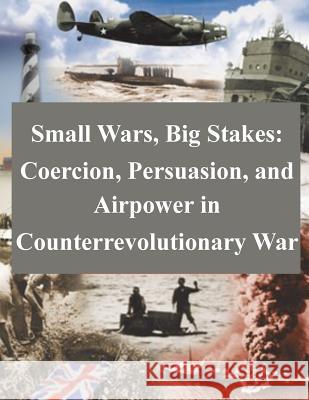Small Wars, Big Stakes: Coercion, Persuasion, and Airpower in Counterrevolutionary War » książka
Small Wars, Big Stakes: Coercion, Persuasion, and Airpower in Counterrevolutionary War
ISBN-13: 9781500500290 / Angielski / Miękka / 2014 / 208 str.
The United States has vital interests to defend in many foreign countries. The strategist must understand the relationship between counterrevolutionary strategy, the military instrument, and airpower if called upon to help a friendly government defeat a revolutionary threat. Four questions can help the strategist explore the nature of this relationship. What is the role of the military instrument in counterrevolutionary warfare? What is the role of airpower in counterrevolutionary warfare? Can airpower achieve strategic effects in counterrevolutionary warfare? Can airpower make major contributions toward the success of counterrevolutionary forces? The strategy development process is a tool that can guide the strategist through a review of revolutionary theory and an analysis of counterrevolutionary strategy. The revolutionary environment must be examined to determine the actors, motivations, aims, and strategies of the revolutionary battlefield. Next, a national counterrevolutionary strategy is formulated that identifies the roles that each instrument of power must play to achieve the desired end-state. Military leaders formulate a subordinate strategy based on the assigned role(s), which includes determining how airpower can best support the national strategy. Strategy execution implies monitoring the instruments of power, reassessing the environment, and modifying ends, ways, and means as appropriate. Theory suggests the government must correctly identify the nature of the revolutionary threat before developing its counterrevolutionary strategy. After determining whether it is facing a partisan or insurgent threat (or something in between), the government tries to identify the correct mixture of persuasive and coercive operations that is needed to win over the people and neutralize the revolutionary threat. Persuasive strategies seek to gain, bolster, or otherwise amass the popular support required for legitimacy. Coercive strategies attempt to neutralize the adversary by making him irrelevant to the political process prior to total military defeat. The military instrument and its airpower tool conduct operations in pursuit of both persuasive and coercive tasks. Three historical cases are analyzed to gain experienced based insights to answer the thesis questions. The cases were the Greek Civil War, 1946-1949; the Malayan Emergency, 1948-1960; and the Insurrection in El Salvador, 1981-1992. In each of these cases the governments struggled to develop a counterrevolutionary strategy. In Greece and Malaya the government successfully neutralized the revolutionary threat. Although the Salvadoran government technically defeated the rebels, they remained an important part of El Salvador's political process. This work offers four conclusions. First, the roles of the military instrument in counterrevolutionary warfare are persuasion and coercion. Next, airpower normally assumes the role assigned to the military instrument, although airpower's unique versatility often permits the simultaneous accomplishment of both persuasive and coercive operations. Third, airpower can create both positive and negative strategic effects. Finally, airpower makes its most important contribution toward the success of counterrevolutionary forces when it is employed in support of ground operations
Zawartość książki może nie spełniać oczekiwań – reklamacje nie obejmują treści, która mogła nie być redakcyjnie ani merytorycznie opracowana.











